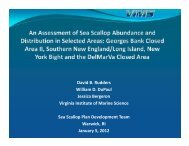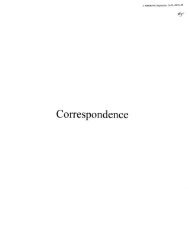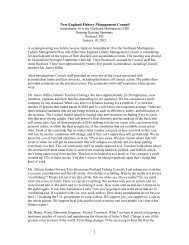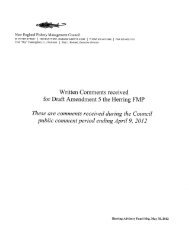Smooth Bottom Net Trawl Fishing Gear Effect on - New England ...
Smooth Bottom Net Trawl Fishing Gear Effect on - New England ...
Smooth Bottom Net Trawl Fishing Gear Effect on - New England ...
Create successful ePaper yourself
Turn your PDF publications into a flip-book with our unique Google optimized e-Paper software.
NOAA/NMFS Unallied Science Project, Cooperative Agreement NA16FL2264 December 2005<br />
<str<strong>on</strong>g>Smooth</str<strong>on</strong>g> <str<strong>on</strong>g>Bottom</str<strong>on</strong>g> <str<strong>on</strong>g>Net</str<strong>on</strong>g> <str<strong>on</strong>g>Trawl</str<strong>on</strong>g> <str<strong>on</strong>g>Fishing</str<strong>on</strong>g> <str<strong>on</strong>g>Gear</str<strong>on</strong>g> <str<strong>on</strong>g>Effect</str<strong>on</strong>g> <strong>on</strong> the Seabed:<br />
Investigati<strong>on</strong> of Temporal and Cumulative <str<strong>on</strong>g>Effect</str<strong>on</strong>g>s BKAM/CR<br />
imposed by trawling. If the community is at the same trophic level, but biomass is lower,<br />
producti<strong>on</strong> must increase relative to biomass if the community is to use primary producti<strong>on</strong> at the<br />
same rate (Jennings et al. 2001)<br />
<str<strong>on</strong>g>Trawl</str<strong>on</strong>g>ing c<strong>on</strong>ducted in this study at Mud Hole and Little Tow in 2001 and 2002 failed to produce<br />
any significant changes in density, species richness, or species compositi<strong>on</strong> of the benthic<br />
infaunal community. Significant differences were attributable to years (2001 versus 2002), sites<br />
(Mud Hole versus Little Tow), seas<strong>on</strong>, and geography. The lack of impact was probably due to a<br />
combinati<strong>on</strong> of the type of gear used, intensity of trawling, and the energy of the envir<strong>on</strong>ment.<br />
There may have been impacts <strong>on</strong> other comp<strong>on</strong>ents of the ecosystem that simply could not be<br />
assessed by the methods used here or the scale of the project. The questi<strong>on</strong> posed is what<br />
intensity of trawling would be necessary to produce measurable impacts <strong>on</strong> the benthic infauna<br />
in this envir<strong>on</strong>ment.<br />
Clearly defined effects of trawling <strong>on</strong> large sessile epifauna, particularly from harder substrates,<br />
has been dem<strong>on</strong>strated in a variety of studies. The significance of the loss of larger epifaunal<br />
species, as dem<strong>on</strong>strated in some studies, with a corresp<strong>on</strong>ding increase in productivity by<br />
smaller opportunistic species needs further investigati<strong>on</strong>. Two approaches might be taken to<br />
further our understanding. One is a detailed investigati<strong>on</strong> of the changes in productivity<br />
resulting from trawl disturbance. <str<strong>on</strong>g>Trawl</str<strong>on</strong>g>ing effects have not been examined across quantifiable<br />
gradients of disturbance (Collie et al. 1997, Kaiser et al. 2000). Another is a more ecosystem<br />
oriented approach, which would evaluate the significance of changes in epifaunal abundance to<br />
overall habitat structure and productivity, and the importance of microhabitat changes for fish<br />
populati<strong>on</strong>s.<br />
50







